History is interesting, isn’t it? In previous versions of HTML, we had very limited manipulation of browsing history. We can go back and forth with what methods we can use, but that's all we can do.
However, using HTML 5’s History API, we can have better control over the browser’s history. For example: we can add a record to the list of history records, or update the URL of the address bar when there is no refresh.
Why introduce History API?
In this article, we will understand the origin of History API in HTML 5. Before this, we often used hash values to alter page content, especially those that were particularly important to the page. Because there is no refresh, it is impossible to change the URL of a single-page application. Additionally, when you change the hash value of a URL, it has no effect on the browser's history.
Then, now with the History API of HTML 5, these are easily implemented, but since single-page applications do not need to use hash values, it may require additional development scripts. It also allows us to build new applications in an SEO-friendly way. Additionally, it reduces bandwidth, but how to prove it?
In this article, I will use the History API to develop a single-page application to prove the above problems.
This also means that I have to load the necessary resources on the homepage first. From now on, the page only loads the required content. In other words, the application does not load all the content at the beginning. It will be loaded when the second application content is requested.
Note that you need to perform some server-side coding to only serve part of the resource, rather than the complete page content.
Browser support
At the time of writing this article, the support for History API by major browsers is very good. You can click here to view its support status. This link will tell you the supported browsers. Before using it, there are always Good practice to detect supported specific features.
In order to determine whether the browser supports this API by changing the method, you can use the following line of code to check:
- return !!(window.history && history.pushState);
In addition, I recommend referring to this article: Detect Support for Various HTML5 Features. (ps: will be translated later)
If you are using a modern browser, you can use the following code:
- if (Modernizr.history) {
- // History API Supported
- }
If your browser does not support History API, you can use history.js instead.
Use History
HTML 5 provides two new methods:
1. history.pushState(); 2. history.replaceState();
Both methods allow us to add and update history, they work the same and can add the same number of parameters. In addition to methods, there is also the popstate event. In the following article, we will introduce how to use and when to use the popstate event.
The parameters of pushState() and replaceState() are the same, and the parameter description is as follows:
1. state: stores JSON string, which can be used in the popstate event.
2. title: Most browsers do not support or ignore this parameter now. It is best to use null instead
3. url: Any valid URL, used to update the browser's address bar, regardless of whether the URL already exists in the address list. What's more, it doesn't reload the page.
The main difference between the two methods is: pushState() adds a new entry to the history stack, and replaceState() replaces the current record value. If you are still confused about this, use some examples to demonstrate the difference.
Suppose we have two stack blocks, one labeled 1 and the other labeled 2, and you have a third stack block labeled 3. When pushState() is executed, stack block 3 will be added to the existing stack, so the stack will have 3 block stacks.
Under the same hypothetical scenario, when replaceState() is executed, block 3 will be placed on the stack of block 2. Therefore, the number of history records remains unchanged, that is to say, pushState() will increase the number of history by 1.
The comparison results are as follows: 
At this point, in order to control the browser's history, we have ignored the pushState() and replaceState() events. But assuming the browser counts a lot of bad records, the user may be redirected to these pages, or maybe not. In this case, unexpected problems arise when users use the browser's forward and back navigation buttons.
Although when we use pushState() and replaceState() for processing, we expect the popstate event to be triggered. But in reality, this is not the case. Instead, when you browse the session history, whether you click the forward or back buttons, or use the history.go and history.back methods, popstate will be triggered.
In WebKit browsers, a popstate event would be triggered after document's onload event, but Firefox and IE do not have this behavior. behavior).
Demo example
HTML:
- div class="container">
- div class="row">
- ul class="nav navbar-nav">
- li>a href="home.html" class="historyAPI">Homea>li>
- li>a href="about.html" class="historyAPI">Abouta>li>
- li>a href="contact.html" class="historyAPI">Contacta>li>
- ul>
- div>
- div class="row">
- div class="col-md-6">
- div class="well">
- Click on Links above to see history API usage using code>pushStatecode> method.
- div>
- div>
- div class="row">
- div class="jumbotron" id="contentHolder">
- h1>Home!h1>
- p>Lorem Ipsum is simply dummy text of the span style="width: auto; height: auto; float: none;" id="5_nwp">a style="text-decoration: none;" mpid="5" target="_blank" href="http://cpro.baidu.com/cpro/ui/uijs.php?adclass=0&app_id=0&c=news&cf=1001&ch=0&di=128&fv=0&is_app=0&jk=f7cb547a6e640f0a&k=printing&k0=printing&kdi0=0&luki=5&n=10&p=baidu&q=06011078_cpr&rb=0&rs=1&seller_id=1&sid=a0f646e7a54cbf7&ssp2=1&stid=0&t=tpclicked3_hc&tu=u1922429&u=http://www.admin10000.com/document/5360.html&urlid=0" id="5_nwl">span style="color:#0000ff;font-size:14px;width:auto;height:auto;float:none;">printingspan>a>span> and typesetting industry.p>
- div>
- div>
- div>
- div>
JavaScript:
- script type="text/span style="width: auto; height: auto; float: none;" id="1_nwp">a style="text-decoration: none;" mpid="1" target="_blank" href="http://cpro.baidu.com/cpro/ui/uijs.php?adclass=0&app_id=0&c=news&cf=1001&ch=0&di=128&fv=0&is_app=0&jk=f7cb547a6e640f0a&k=javascript&k0=javascript&kdi0=0&luki=8&n=10&p=baidu&q=06011078_cpr&rb=0&rs=1&seller_id=1&sid=a0f646e7a54cbf7&ssp2=1&stid=0&t=tpclicked3_hc&tu=u1922429&u=http://www.admin10000.com/document/5360.html&urlid=0" id="1_nwl">span style="color:#0000ff;font-size:14px;width:auto;height:auto;float:none;">javascriptspan>a>span>">
- jQuery('document').ready(function(){
- jQuery('.historyAPI').on('click', function(e){
- e.preventDefault();
- var href = $(this).attr('href');
- // Getting Content
- getContent(href, true);
- jQuery('.historyAPI').removeClass('active');
- $(this).span style="width: auto; height: auto; float: none;" id="2_nwp">a style="text-decoration: none;" mpid="2" target="_blank" href="http://cpro.baidu.com/cpro/ui/uijs.php?adclass=0&app_id=0&c=news&cf=1001&ch=0&di=128&fv=0&is_app=0&jk=f7cb547a6e640f0a&k=add&k0=add&kdi0=0&luki=3&n=10&p=baidu&q=06011078_cpr&rb=0&rs=1&seller_id=1&sid=a0f646e7a54cbf7&ssp2=1&stid=0&t=tpclicked3_hc&tu=u1922429&u=http://www.admin10000.com/document/5360.html&urlid=0" id="2_nwl">span style="color:#0000ff;font-size:14px;width:auto;height:auto;float:none;">addspan>a>span>Class('active');
- });
- });
- // Adding popstate event listener to handle browser back button
- window.addEventListener("popstate", function(e) {
- // Get State value using e.state
- getContent(location.pathname, false);
- });
- function getContent(url, addEntry) {
- $.get(url)
- .done(function( span style="width: auto; height: auto; float: none;" id="3_nwp">a style="text-decoration: none;" mpid="3" target="_blank" href="http://cpro.baidu.com/cpro/ui/uijs.php?adclass=0&app_id=0&c=news&cf=1001&ch=0&di=128&fv=0&is_app=0&jk=f7cb547a6e640f0a&k=data&k0=data&kdi0=0&luki=6&n=10&p=baidu&q=06011078_cpr&rb=0&rs=1&seller_id=1&sid=a0f646e7a54cbf7&ssp2=1&stid=0&t=tpclicked3_hc&tu=u1922429&u=http://www.admin10000.com/document/5360.html&urlid=0" id="3_nwl">span style="color:#0000ff;font-size:14px;width:auto;height:auto;float:none;">dataspan>a>span> ) {
- // Updating Content on Page
- $('#contentHolder').html(data);
- if(span style="width: auto; height: auto; float: none;" id="4_nwp">a style="text-decoration: none;" mpid="4" target="_blank" href="http://cpro.baidu.com/cpro/ui/uijs.php?adclass=0&app_id=0&c=news&cf=1001&ch=0&di=128&fv=0&is_app=0&jk=f7cb547a6e640f0a&k=add&k0=add&kdi0=0&luki=3&n=10&p=baidu&q=06011078_cpr&rb=0&rs=1&seller_id=1&sid=a0f646e7a54cbf7&ssp2=1&stid=0&t=tpclicked3_hc&tu=u1922429&u=http://www.admin10000.com/document/5360.html&urlid=0" id="4_nwl">span style="color:#0000ff;font-size:14px;width:auto;height:auto;float:none;">addspan>a>span>Entry == true) {
- // Add History Entry using pushState
- history.pushState(null, null, url);
- }
- });
- }
- script>
总结(ps:喜欢这两个字~~~^_^~~~)
HTML 5中的History API 对Web应用有着很大的影响。为了更容易的创建有效率的、对SEO友好的单页面应用,它移除了对散列值的依赖。
 html5的div一行可以放两个吗Apr 25, 2022 pm 05:32 PM
html5的div一行可以放两个吗Apr 25, 2022 pm 05:32 PMhtml5的div元素默认一行不可以放两个。div是一个块级元素,一个元素会独占一行,两个div默认无法在同一行显示;但可以通过给div元素添加“display:inline;”样式,将其转为行内元素,就可以实现多个div在同一行显示了。
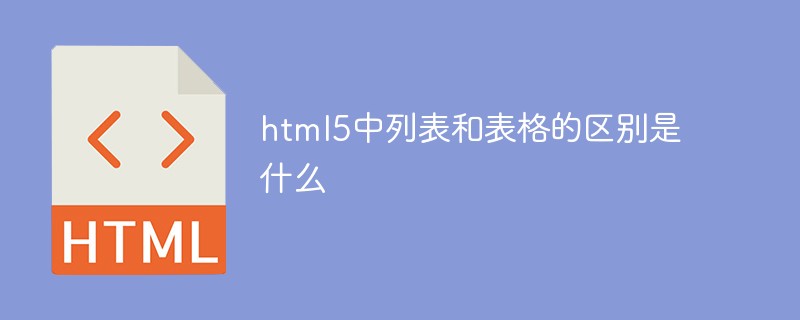 html5中列表和表格的区别是什么Apr 28, 2022 pm 01:58 PM
html5中列表和表格的区别是什么Apr 28, 2022 pm 01:58 PMhtml5中列表和表格的区别:1、表格主要是用于显示数据的,而列表主要是用于给数据进行布局;2、表格是使用table标签配合tr、td、th等标签进行定义的,列表是利用li标签配合ol、ul等标签进行定义的。
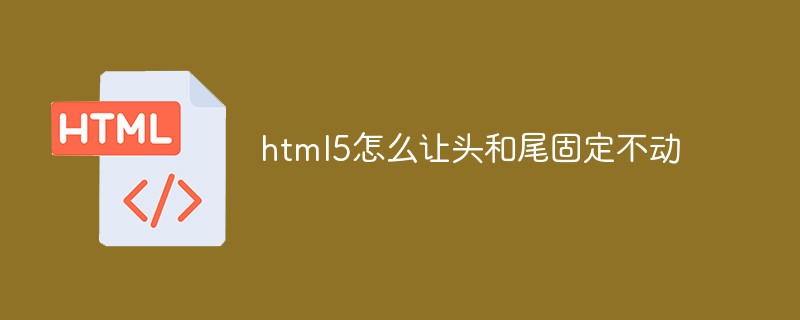 html5怎么让头和尾固定不动Apr 25, 2022 pm 02:30 PM
html5怎么让头和尾固定不动Apr 25, 2022 pm 02:30 PM固定方法:1、使用header标签定义文档头部内容,并添加“position:fixed;top:0;”样式让其固定不动;2、使用footer标签定义尾部内容,并添加“position: fixed;bottom: 0;”样式让其固定不动。
 HTML5中画布标签是什么May 18, 2022 pm 04:55 PM
HTML5中画布标签是什么May 18, 2022 pm 04:55 PMHTML5中画布标签是“<canvas>”。canvas标签用于图形的绘制,它只是一个矩形的图形容器,绘制图形必须通过脚本(通常是JavaScript)来完成;开发者可利用多种js方法来在canvas中绘制路径、盒、圆、字符以及添加图像等。
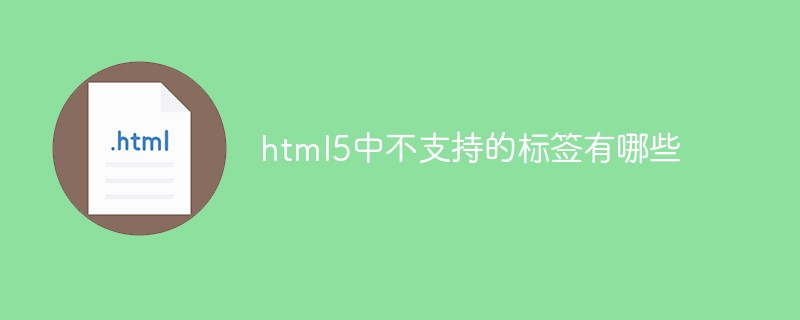 html5中不支持的标签有哪些Mar 17, 2022 pm 05:43 PM
html5中不支持的标签有哪些Mar 17, 2022 pm 05:43 PMhtml5中不支持的标签有:1、acronym,用于定义首字母缩写,可用abbr替代;2、basefont,可利用css样式替代;3、applet,可用object替代;4、dir,定义目录列表,可用ul替代;5、big,定义大号文本等等。
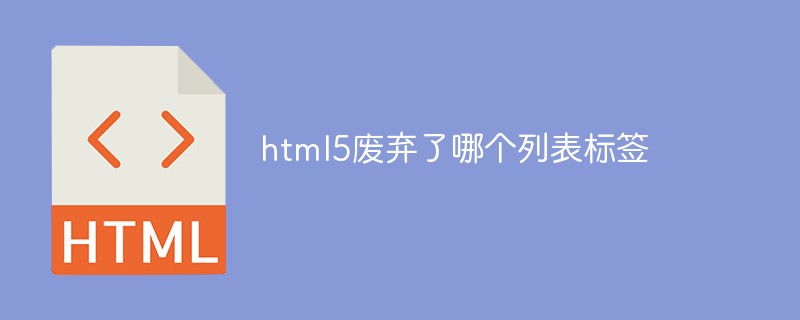 html5废弃了哪个列表标签Jun 01, 2022 pm 06:32 PM
html5废弃了哪个列表标签Jun 01, 2022 pm 06:32 PMhtml5废弃了dir列表标签。dir标签被用来定义目录列表,一般和li标签配合使用,在dir标签对中通过li标签来设置列表项,语法“<dir><li>列表项值</li>...</dir>”。HTML5已经不支持dir,可使用ul标签取代。
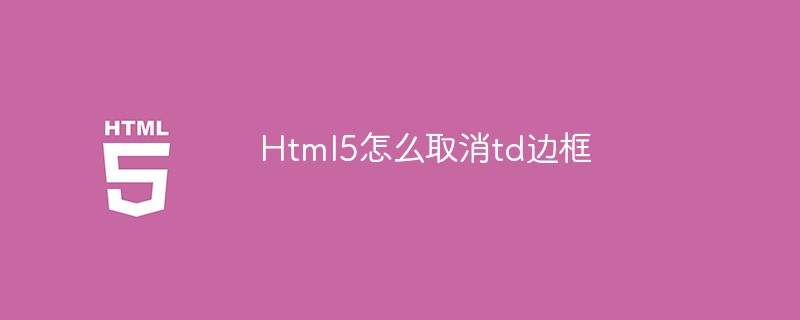 Html5怎么取消td边框May 18, 2022 pm 06:57 PM
Html5怎么取消td边框May 18, 2022 pm 06:57 PM3种取消方法:1、给td元素添加“border:none”无边框样式即可,语法“td{border:none}”。2、给td元素添加“border:0”样式,语法“td{border:0;}”,将td边框的宽度设置为0即可。3、给td元素添加“border:transparent”样式,语法“td{border:transparent;}”,将td边框的颜色设置为透明即可。
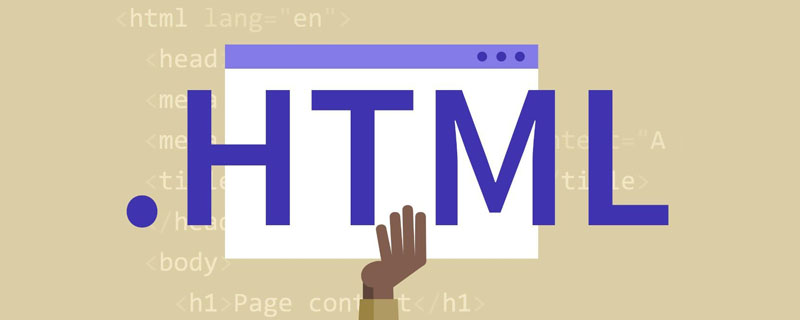 html5是什么意思Apr 26, 2021 pm 03:02 PM
html5是什么意思Apr 26, 2021 pm 03:02 PMhtml5是指超文本标记语言(HTML)的第五次重大修改,即第5代HTML。HTML5是Web中核心语言HTML的规范,用户使用任何手段进行网页浏览时看到的内容原本都是HTML格式的,在浏览器中通过一些技术处理将其转换成为了可识别的信息。HTML5由不同的技术构成,其在互联网中得到了非常广泛的应用,提供更多增强网络应用的标准机。


Hot AI Tools

Undresser.AI Undress
AI-powered app for creating realistic nude photos

AI Clothes Remover
Online AI tool for removing clothes from photos.

Undress AI Tool
Undress images for free

Clothoff.io
AI clothes remover

AI Hentai Generator
Generate AI Hentai for free.

Hot Article

Hot Tools

MantisBT
Mantis is an easy-to-deploy web-based defect tracking tool designed to aid in product defect tracking. It requires PHP, MySQL and a web server. Check out our demo and hosting services.

Atom editor mac version download
The most popular open source editor

Dreamweaver Mac version
Visual web development tools

Notepad++7.3.1
Easy-to-use and free code editor

SublimeText3 English version
Recommended: Win version, supports code prompts!






